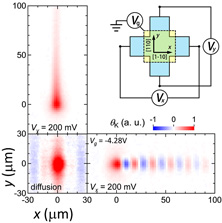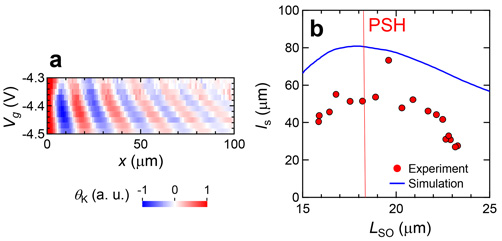Long-distance Transport of Electron Spins in Persistent Spin Helix State
Future information processing techniques using electron spins in non-magnetic semiconductors will require both the manipulation and transfer of spins without their coherence being lost. The effective magnetic field induced by a spin-orbit interaction (SOI) enables us to rotate the electron spins in the absence of an external magnetic field. However, the fluctuations in the effective magnetic field originating from the random scattering of electrons also cause undesirable spin decoherence, which limits the length scale of the spin transport. Here we report the electrical control of spin precession of drifting electrons in a robust spin structure, namely a persistent spin helix (PSH) where the Rashba and Dresselhaus SOIs are the same strength. We found that the PSH enhances the spatial coherence of drifting spins, resulting in a maximized spin decay length near the PSH condition. We also found that the spin precession period of drifting spins can be controlled by a gate-controlled SOI [1].
The sample consisted of a 25-nm-thick GaAs QW embedded in a HEMT structure. The wafer was processed into a cross-shaped channel with a top gate electrode (Fig. 1 inset). This structure allowed us to use in-plane voltages Vx and Vy to create drift motion, and a vertical gate voltage Vg to tune the strengths of the SOIs. We measured the spatial spin distribution of drifting electrons using Kerr rotation microscopy at T = 8 K. A circularly polarized pump light from a cw Ti:sapphire laser generated electron spins at a certain position and a linearly polarized light probed the Kerr rotation θK, which was proportional to the spin density at the focused position. Figure 2(a) shows the Vg dependence of the Kerr rotation angle θK scanned along the [1-10] direction for Vx = 50 mV and Vy = 0 mV. Even in the absence of an external magnetic field, we observed a spin precession resulting from the effective magnetic field induced by the SOIs. By varying the gate voltage, the spatial frequency of the drifting spin precession was continuously modulated via the gate control of the Rashba SOI. We also estimated the gate voltage dependence of the spin decay length lS over which the spin density decays to 1/e of its initial value. In Fig. 2(b), lS is plotted as a function of the spin rotation length LSO, which is inversely proportional to the SOI. We found that lS has its maximum value in the PSH condition, and this behavior was well reproduced by a simulation based on a spin drift-diffusion model. A comparison of the experimental and simulation results reveals that in the present sample the spin decay length is enhanced by suppressing the spin relaxation in the PSH condition.
- [1] Y. Kunihashi, H. Sanada, H. Gotoh, K. Onomitsu, M. Kohda, J. Nitta, and T. Sogawa, Nature Commun. 7, 10722 (2016).

|

|
| Fig. 1. Spatial distribution of diffusive and drifting spins in the PSH state. The inset shows a schematic image of the sample. | Fig. 2. (a) Gate voltage dependence of the spatial distribution of drifting spins in the [1-10] direction. (b) Spin decay length lS as a function of spin rotation length LSO in which an electron spin can rotate a full cycle. |